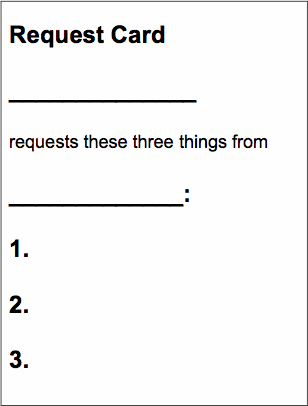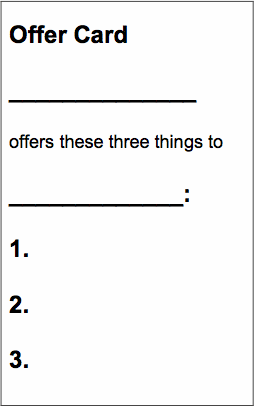THIAGI GAMELETTER:
March 2012
SERIOUSLY FUN ACTIVITIES FOR TRAINERS, FACILITATORS,
PERFORMANCE CONSULTANTS, AND MANAGERS.
TABLE OF CONTENTS
Masthead
Our mission statement, copyright notice, and cast
of characters.
US Workshops
(Advertisement) Energize Your Training the Thiagi
Way
With a special discount for TGL
readers.
International Workshops
Around the World with Thiagi
Oslo, Zurich, Paris, Vancouver, and
more.
Roleplay
Requests and Offers
Or is it a card game?
Guest Gamer
An Interview with Mark Isabella
He enjoys the best of two worlds.
Magic
It's In The Cards by Mark Isabella
Mind reading and nonverbal
communication.
Jolt
From Hand To Mouth by Tracy Tagliati
Reducing mindless behavior.
Puzzle
Board Games
Bored? Play a board game.
Online Game
World Capitals
Match each country with its capital.
From Brian's Brain
Fight, Flight, or Friendship by Brian Remer
A link to the latest issue of Brian's
newsletter.
Scenario-Based Survey
Grabbing Webinar Attendees' Attention by Tracy Tagliati
Make your webinars engaging.
Survey Results
Instant Messages by Tracy Tagliati
A summary of your responses.
Check It Out
BoardGameGeek ( http://boardgamegeek.com/ )
Never be bored with board games.
Masthead
THIAGI GAMELETTER:
SERIOUSLY FUN ACTIVITIES FOR TRAINERS, FACILITATORS,
PERFORMANCE CONSULTANTS, AND MANAGERS.
Mission
To increase and improve the use of interactive,
experiential strategies to improve human performance in an
effective, efficient, and enjoyable way.
Editorial Roster
 Author and Editor
: Sivasailam (Thiagi) Thiagarajan
Author and Editor
: Sivasailam (Thiagi) Thiagarajan
 Assistant Editor
: Raja Thiagarajan
Assistant Editor
: Raja Thiagarajan
Associate Editors: Tracy Tagliati and Jean Reese
Contributing Editors: Brian Remer
Editorial Advisory Board: Bill Wake, Matthew Richter, Samuel van den Bergh, and <type your name here>
Copyright Info
The materials in this newsletter are copyright 2012 by The
Thiagi Group. However, they may be freely reproduced for
educational/training activities. There is no need to obtain
special permission for such use as long as you do not
reproduce more than 100 copies per year. Please
include the following statement on all reproductions:
Reprinted from THIAGI GAMELETTER. Copyright © 2012
by The Thiagi Group, Inc.
For any other use of the content, please contact us (
thiagi@thiagi.com ) for permission.
Subscription Info
To sign up, or to donate and help us continue this
newsletter, please see the Online
Newsletter page on our website (
http://thiagi.com/pfp.html ).
Feedback Request
Thiagi believes in practicing what he preaches. This is an
interactive newsletter, so interact already! Send us your
feedback, sarcastic remarks, and gratuitous advice through
email to thiagi@thiagi.com . Thanks!
[Table of Contents]
US Workshops
(Advertisement) Energize Your Training the Thiagi
Way
Take Thiagi's 3-day workshop on Interactive Techniques
for Instructor-Led Training
Who will benefit the most if you attend this workshop?
The people who participate in your training
sessions.
Your participants will be intrigued and engaged by the
training activities that you design, tweak, and
facilitate.
Your participants will work through a variety of
know-how right-now activities:
-
Openers that jump start your session
and establish a climate of caring and sharing
-
Interactive lectures that combine
structure and control with playfulness and
spontaneity
-
Structured sharing activities that
let your participants learn with, and learn from, each
other
-
Textra games that convert dull
handouts into dynamic tools
-
Jolts that last for less than 3
minutes and provide a lifetime of insights
-
Closers that review the new skills
and plan for their immediate application
Board games, card games, improv games,
instructional puzzles, magic and other activities
you conduct will drive your participants to high levels of
fluency—without their realizing they are learning
hard stuff.
Simulation games, action learning, the case method,
role-playing, and reflective
debriefing—these are the types of authentic
activities you will conduct in your real and virtual
classrooms.
What Participants Say
I have already used, modified, and had fun and success with
these activities within my courses…rescheduling my
training two days later to incorporate a game. It worked
like a dream.—Eileen Kupper
Three months later, I find myself reflecting to further
enrich from what was my most engaging learning experience
ever—and yes, I am still laughing!—Dimis
Michaelides
It was an amazing three days, and Thiagi brought out the
best in our group of participants.—Marianne
Goodwin
What You Take Home
In addition to your new set of skills and knowledge, you
will have tangible products:
- Three hefty manuals with ready-to-use training games
and activities and templates for creating your own
- Access to Thiagi's online collection of 350 training
games
- A monthly newsletter with new training activities and
facilitation tips
Register Today and Save $370
Because you are a reader of TGL, you may
register at the discounted rate of $1,125 ($370 off the
regular rate).
Register for this workshop by calling Brenda at (812)
332-1478, or visit our
online store, or go to http://bit.ly/zJZNa4
.
Reserve a room at the hotel by calling (317) 684-7733 and
mentioning group code thithib , or visit the hotel website, or go
to http://bit.ly/zmOtLF .
Register
Now!
Reserve your hotel
room
Basic Information
What? Interactive Techniques for
Instructor-Led Training: A 3-Day Workshop
When? March 21-23, 2012 (Wednesday thru
Friday). Wednesday-Thursday: 9am-5pm, Friday: 9am-4pm
Where? Courtyard Indianapolis at the
Capitol, Indianapolis, Indiana, USA. They have a web page at
http://www.marriott.com/hotels/travel/indcd-courtyard-indianapolis-at-the-capitol/
How much? Regular registration rate:
$1,495. TGL readers can get a discount
of $370. Click here to register at this special rate.
By Whom? The workshop is designed and
delivered by Thiagi. No bait and switch.
For Whom? Trainers, facilitators,
instructional designers, performance consultants, and
managers.
For more about the workshop, take a look at our detailed brochure (190K PDF).
[Table of
Contents]
International Workshops
Around the World with Thiagi
Here's an update of our plans for international
workshops.
Already Scheduled
Norway
Oslo, Norway
Interactive Training
Strategies, May 21-22, 2012
Organized by Silje Bull-Njaa Larsen of Inovati
Switzerland
Winterthur, Switzerland (near Zurich)
Interactive Training
Strategies, June 4-6, 2012.
Design Clinic and Advanced Interactive
Strategies, June 7-8, 2012
http://www.diversityandinclusion.net/index2.cfm?page=kurse
Organized by Samuel van den Bergh of van den Bergh Thiagi
Associates
France
Paris, France
Interactive Training
Strategies, November 20-23,
2012
Organized by Bruno Hourst and his team at
Mieux-Apprendre ( http://mieux-apprendre.com/ )
Canada
Vancouver, British Columbia
Designing and Delivering Interactive
Training: New Techniques from Thiagi
, December 6-7, 2012
Organized by
David Gouthro of The Consulting Edge ( http://www.theconsultingedge.com/ )
Help Needed
I am planning to organize workshops in the following
countries. If you are interested in helping me organize one
of these workshops—or attending one of
them—please email me at thiagi@thiagi.com
.
Australia
I have conducted several workshops in different locations
in Australia—until my best Aussie friend and
collaborator Marie Jasinski died unexpectedly. I decided
it is time for me to get back down under. I have several
interested people in Sydney and in Melbourne.
Holland
I have several friends in Holland and I heard from a
couple of them who are interested in organizing my
workshop in Amsterdam. Unfortunately, I lost the email. (I
agree: I am sloppy.)
India
I'd like to organize workshops in Mumbai, Bengaluru, and
Chennai. If you are interested in this project, please
email me at thiagi@thiagi.com .
[Table of
Contents]
Roleplay
Requests and Offers
Several years ago, working with my Swiss teammates, I
designed a game called Give and Take. I
have frequently watched my colleague Sam brilliantly conduct
this activity. Based on these observations, I have streamlined
the activity and renamed it.
Requests and Offers is a 3-person
roleplay involving an imaginary project. Later, we encourage
the participants to apply what they learned from this roleplay
to real-world discussion among project team members.
Synopsis
Each team consists of three members working on a joint
project. Each member (who has a set of specific
responsibilities) writes a list of three requests and three
offers for the other members. Later the team members match
these mutual requests and offers and compute an empathy
score. Finally, team members negotiate among themselves and
adjust their requests and offers to achieve an improved
common understanding of the project goal.
Purpose
To determine the roles and responsibilities among the team
members for achieving a common goal.
Participants
Minimum: 3
Maximum: Any number (organized into teams
of three)
Best: 12 to 30
Time
40 minutes to 2 hours
Supplies
Request Cards (4 cards
for each participant)
Offer Cards (4 cards for
each participant)
Paper
Pens or Pencils
Countdown timer
Preparation
Read and rehearse. Review the flow of
activities. Study the examples and learn how to compute the
empathy score. Come up with your own example to
be used when you give instructions to the participants.
Flow
Form triads. Divide the participants into
teams of three. If you have one person left over, ask her to
join a team as an observer. If you have two people left
over, form a triad that includes you.
Specify a goal. Explain that the three
members form a project team. Ask each team to come up with
an imaginary (but realistic) project that will utilize their
individual talents. Ask the teams to specify a goal for this
project. Give examples of appropriate goals such as
these:
- Create a website for your organization
- Design a new product for 7-year olds
- Organize a bake sale
- Plan a trip to Australia (or to Austria, if you live
in Australia)
- Produce a video for YouTube
- Start a professional organization
Announce a suitable time limit for completing this
task.
Assign roles and responsibilities. Ask
each team member to take on a set of responsibilities for
achieving the project goal. Each person should have a
specific role identified by a job title. Ask the teams to
list the responsibilities associated with each role. Give
some examples and announce a time limit.
Example: Your triad decides to publish an e-book on
marketing techniques. Here are the three roles that you
created: Expert, Writer, and Tech Specialist. Among the
specific responsibilities, the Expert is responsible for
creating the content, the Writer is responsible for
writing the book, and the Tech Specialist will be
responsible for transforming the copy into an e-book.
Write request cards. Ask the three team
members to work independently during the next activity. Ask
each person to think of what she wants from the other two
members of the project team. She writes a request card for
each of the other two team members. The card should contain
three important things she needs from the other person. Give
suitable examples and announce a time limit.
Examples from the e-book team:
The Expert requests these three things from the
Writer:
- Specifications for the format in which I should
submit the content.
- Rapid conversion of my outline and ideas into
finished materials.
- Willingness to rewrite the content until I am
satisfied.
The Expert requests these three things from the Tech
Specialist:
- Explanation of what she will be doing with the
content.
- Two or three alternate e-book formats (from which I
will choose the one I like the best).
- Frequent progress reports.
The Writer requests these three things from the
Expert:
- A detailed outline of the entire book.
- Draft copies of the materials for each
chapter.
- List of reference materials to help me get
sufficient background on the topic.
The Writer requests these three things from the Tech
Specialist:
- A style sheet specifying the format in which the
content is to be submitted.
- A list of font and layout options for the final
version.
- Making changes to the final format based on my
feedback.
The Tech Specialist requests these three things from the
Expert:
- Background information on the content of the
book.
- List of formatting preferences.
- Initial specifications about the size and
organization of the book.
The Tech Specialist requests these three things from the
Writer:
- A wish list of what the e-book should look
like.
- A schedule.
- Rapid feedback on the preliminary layout of each
chapter.
Write offer cards. Ask the three members
to continue working independently. This time, ask the team
members to write an offer card for each of the other two
members. The card should contain three most important things
she is offering to the other person. Give some examples and
announce a suitable time limit.
Examples of offer cards from the e-book team:
The Expert offers these three things to the Writer:
- An explanation of the conceptual framework for the
book.
- A discussion of how the proposed book compares with
competing books.
- A list of references that will provide additional
background information.
The Expert offers these three things to the Tech
Specialist:
- An explanation of the conceptual framework for the
book.
- List of specifications for the proposed
e-book.
- Help in marketing the e-book.
The Writer offers these three things to the Expert:
- Samples of different writing styles.
- Rapid production of draft copy from the Expert's
outline.
- Knowledge about the preferences of the audience for
the e-book.
The Writer offers these three things to the Tech
Specialist:
- A list of reader preferences and dislikes about
e-books.
- Suggestions for improving the readability of
e-books.
- A guarantee not to make any changes in the final
copy.
The Tech Specialist offers these three things to the
Expert:
- The use of latest technology tools for producing
e-books.
- Suggestions for improving the marketability of
e-books.
- Feedback on the clarity and usefulness of the
content.
The Tech Specialist offers these three things to the
Writer:
- An online tool that will help the Writer preview
each chapter.
- A clear indication of how much time is required for
converting each chapter into an e-book chapter.
- Discussion about what the e-book can and cannot
do.
Align the cards. Make sure that each
person has written two request cards and two offer cards,
one of each type for each of the two other members of the
team. Now ask the team members to combine the cards into
these six pairs so that the requests and offers that involve
the same two people can be compared easily:
- A's offers to B. B's requests from A.
- A's offers to C. C's requests from A.
- B's offers to A. A's requests from B.
- B's offers to C. C's requests from B.
- C's offers to A. A's requests from C.
- C's offers to B. B's requests from C.
Example: Here's how the two cards that involve the Expert
and the Writer are paired up:
The Expert requests these three things from the
Writer:
- Specifications for the format in which I should
submit the content.
- Rapid conversion of my outline and ideas into
finished materials.
- Willingness to rewrite the content until I am
satisfied.
The Writer offers these three things to the Expert:
- Samples of different writing styles.
- Rapid production of draft copy from the Expert's
outline.
- Knowledge about the preferences of the audience for
the e-book.
Compute the empathy score. Ask the members
of each project team to compare the offers and requests that
involve the same pair of team members. Ask them to award one
point each time a person's offer matches the other person's
request. Ask the team members to repeat these comparisons
with all three pairs of cards. Explain that the total number
of points constitutes the empathy score for the project
team.
The maximum number of points for each pair of cards is six.
Therefore, if there were a perfect match among all offers
and requests, the team's empathy score would be 18. However,
such perfect understanding is very unlikely. Assign a
suitable time limit and ask the teams to compute their
empathy scores. Walk among the teams, helping them if
necessary.
Example: When we compare what the Expert requests from
the Writer with what the Writer offers the Expert, we see
a match in working rapidly to convert the Expert's content
into the Writer's chapters. This match earns one point.
The other requests and offers do not match.
Compare scores among different teams.
Identify the team with the highest empathy score and
congratulate its members.
Improve the empathy scores. Now ask each
team to negotiate among themselves and revise their requests
and offers to earn a perfect empathy score of 18. This
process may involve give and take among different requests
and offers. Announce a suitable time limit for the
discussions among team members.
Debriefing
Explain to the participants that the ultimate purpose of
this roleplay is to encourage them to discuss their roles
and responsibilities in their real-world projects. To help
them to apply the useful things they learned from this
activity, ask and discuss these types of questions:
- Low empathy scores indicate that different team
members have different mental models of the project, its
goal, and the division of labor. What could we have done
earlier about specifying the team goal and assigning roles
that would have increased the empathy score?
- What could we have done in specifying the project
goals and assigning the three roles that would have
increased your initial empathy score?
- High empathy scores indicate that all team members
have the same ideas about the project, its goal, and the
division of labor. Is this a healthy state of
affairs?
- Did your project require additional roles and
responsibilities? How would you have handled these
responsibilities?
- We limited you to three requests and offers. Did this
force you to ignore some other important requirements and
responsibilities?
- What techniques did you use during your negotiations
to improve your empathy score?
Encourage the participants to talk to each other about
their real-world projects and plan how to use their new
insights to improve their teamwork.
Cards
Request Card

Offer Card

[Table of
Contents]
Guest Gamer
 Mark Isabella enjoys the
best of two worlds, serving as an external consultant with
his company, Isabella & Associates ( http://isabellaandassociates.com ), and as an
internal practitioner with the West Virginia Division of
Personnel's Organization and Human Resource Development
office. He has spent 18+ years working with clients from
health care, manufacturing, public and higher education, law
enforcement, corrections, finance, engineering,
construction, hospitality, and social services. All of his
training programs combine research-based content with
interactive strategies.
Mark Isabella enjoys the
best of two worlds, serving as an external consultant with
his company, Isabella & Associates ( http://isabellaandassociates.com ), and as an
internal practitioner with the West Virginia Division of
Personnel's Organization and Human Resource Development
office. He has spent 18+ years working with clients from
health care, manufacturing, public and higher education, law
enforcement, corrections, finance, engineering,
construction, hospitality, and social services. All of his
training programs combine research-based content with
interactive strategies.
Mark coauthored Let's Deal with
Conflict! with Thiagi and contributed to
The 2011 Pfeiffer Annual: Training.
He is a member of the American Society for Training and
Development, the NeuroLeadership Institute, and the
International Society for Performance Improvement, which has
designated him as a Certified Performance Technologist.
An Interview with Mark Isabella
TGL: Mark, what's your specialty
area?
Mark: In my private business, my training
has focused on leadership, communication, conflict management,
change leadership, team building, and coaching. In my public
sector role, I tackle those topics and many others, including
organizational politics, performance management, and
train-the-trainer. I also offer coaching, consulting, and
facilitation services.
TGL: How long have you been designing and
using games?
Mark: I've used games in my programs since my
very first session as a professional trainer. My initial
assignment was a full-day workshop on proofreading, and I was
concerned that participants were going to be bored. So I
combined some practice sessions with puzzles and a game show
recap. The reaction was overwhelmingly positive, and I was
hooked. Around the same time, I received some sage advice from
an experienced facilitator about audience members. With a very
serious look on his face, he told me, “Always remember that
there are lots and lots of them and only one of you. If they
feel like it, they can rush the podium at any time.” That
bit of wisdom has always motivated me to create an engaging
classroom environment.
TGL: Where do you use games?
Mark: Everywhere I can—workshops,
retreats, keynotes, and coaching interventions. I also use
games to motivate myself to perform unpleasant tasks around my
home and office. My favorite definition of play comes from
authors Katie Salen and Eric Zimmerman: “Play is the free
space of movement within a more rigid structure.” Because
games can help us overcome barriers and resistance, we should
use them not just as training tools or recreational
activities, but as a means to a happier and more creative
life.
TGL: How do your clients
respond?
Mark: My clients have always been amenable to
the use of interactive strategies. If you offer solid content
that addresses relevant business needs, customers will remain
open to a creative approach. Using a co-design strategy is
also beneficial. Active involvement in the design process
tends to generate higher levels of enthusiasm and support
among your clients.
TGL: What is an embarrassing moment you had
in the classroom?
Mark: Just after I entered the field, I was
scheduled to facilitate a workshop on relationship building
for experienced middle managers. Right before the program was
to begin, one of the participants got my attention and
said—in a voice loud enough for all to
hear—“Son, I hope you realize that you're not going
to teach us anything today!” His statement made the
transition to my lofty program overview a little awkward.
Fortunately, I haven't experienced that level of resistance
since then. And strangely, no one has called me “Son” in
many, many years.
TGL: What types of games do you use most
frequently?
Mark: My goal has been to learn and use as
many types of interactive strategies as possible. My standbys
are card games, simulations, the case method, role plays,
jolts, art, mind-reading, improv, openers and closers,
textras, interactive lectures, and instructional puzzles. I
spend between 80 and 100 days in the classroom each year and
serve a diverse audience base, so I'm always seeking to expand
my repertoire.
TGL: Who are your favorite game
designers?
Mark: The works of the late Mel Silberman got
me started in interactive training. I've always been a fan of
The Pfeiffer Annuals, most recently
edited by Elaine Biech. The activities from the
Gamestorming book and website are
superb. My biggest influence has been that of the ageless
wizard, Thiagi. His workshops and books have dramatically
changed my approach to design, development, and
delivery.
TGL: Do you have any book
recommendations?
Mark: Stuart Brown's
Play and James Carse's
Finite and Infinite Games reveal the
many possibilities and benefits of a playful approach to life.
Trickster Makes This World, by Lewis
Hyde, reminds us that mischief, disorder, and provocation can
coalesce in ways that makes us wiser, freer, and more
creative.
TGL: What is your prediction about the future
of games?
Mark: I think it will be difficult for any
trainer or presenter to succeed in the future without some
skill in the use of interactive techniques. Today's audiences
want good content and a creative environment. Many
speakers and trainers have already accepted that reality and
are seeking to enhance their design, development, and delivery
skills. The trend toward active engagement will only
accelerate and grow in the future.
TGL: What advice would you offer newcomers
about interactive training?
Mark: Remember that your training is not
about you—it's about your clients and your
participants. Draw upon a variety of strategies, and don't be
afraid to try new approaches. Most importantly, maintain a
playful spirit. Don't take yourself seriously, learn from your
mistakes, and enjoy the best job in the world.
[Table of
Contents]
Magic
It's In The Cards
by Mark Isabella
 Instructional magic is a
flexible and engaging strategy that can spice up any training
session. Here's an easy mind-reading effect that can be
learned in just a few minutes and used in a variety of
settings.
Instructional magic is a
flexible and engaging strategy that can spice up any training
session. Here's an easy mind-reading effect that can be
learned in just a few minutes and used in a variety of
settings.
Synopsis
The trainer identifies the value of two playing cards
secretly chosen by a volunteer.
Purpose
The trick can serve as an introduction to a training module
on nonverbal communication, conflict management, or
negotiation. It can also be adapted to other content
areas.
Participants
One volunteer who assists with the trick. The rest of the
group (best size 10 to 30) acts as observers.
Time
Approximately 5 to 10 minutes.
Supplies
A prepared deck of playing cards.
Preparation
- Before the activity, remove all the tens, jacks,
queens, kings, and jokers from a standard deck of
cards.
- Have a sheet of paper and a pen handy.
Flow
- Tell the group that you wish to conduct an experiment
in the art of mindreading.
- Ask a volunteer (let's call her Peggy) to shuffle the
cards.
- Take the deck back, fan the cards, and ask Peggy to
choose one.
- Have her memorize her chosen card and place it face
down on the table in front of her.
- Give Peggy the paper and pen. Ask her to write down
the value of the card she just chose from the deck (aces
count as one).
- Next, have Peggy double the value of the card she
chose and add five.
- Have Peggy multiply the new total by five.
- Now ask her to choose another card from the deck, look
at it, memorize it, and place it face down alongside the
first chosen card.
- Have Peggy return to her calculations and add the
value of the second card to the last total on the
paper.
- Then, have her announce the final total to the entire
group.
- Here's where the secret move takes place: You will be
able to easily determine the value of the cards with a
simple mental calculation. Take the volunteer's final
total and mentally subtract 25 from it. This two-digit
number will provide the value of the chosen cards. So, if
Peggy announces that her final total is 87, subtract 25 to
arrive at the number 62. One of the chosen cards will be a
six; the other will be a two.
- Once you have completed your mental calculation, ask
Peggy to think about the two cards that she chose.
Encourage her to create a mental picture of those cards.
You might ask her to make that mental image bigger than
normal, or imagine it glowing and pulsating in her
mind.
- Look intently into Peggy's eyes. Hold your index
finger to your temple, close your eyes, and demonstrate
intense concentration. Dramatically announce the value of
one of the cards. Verify that your choice is correct by
having Peggy reveal that card to the other
participants.
- Return to a state of deep thought. Then announce the
value of the other card. Verify the accuracy of that
choice by having Peggy reveal the remaining card.
- Accept the group's applause, feign mental exhaustion
for a second or two, and then link the effect to your
topic.
How To Use This Trick
Here is one way to transition from the trick to your
training content:
Despite Peggy's efforts to keep her chosen cards hidden,
I was successful in knowing exactly what she was holding.
How many of you believe that I have well-honed psychic
abilities?
Typically, a good sport in the group will raise a hand.
Due to restrictions in my contract with the United
Federation of Phony Psychics, I cannot reveal my methods.
Let's instead turn to the connections between this
experiment and our next topic.
Experts in the areas of negotiation, communication, and
conflict management tell us that it is sometimes best to
leave certain information unrevealed—that is, to
keep our cards close to the vest. And yet, we often find
ourselves in negotiations where the other party seems to
know exactly what we're thinking. Discounting the
possibility that they possess the ability to read minds,
how do they discern our emotional state, our weaknesses,
and our pressure points?
One or more of your participants will probably identify
nonverbal signs as the means by which we communicate
information that we would rather not reveal.
We frequently offer hidden information to others through
our nonverbal communication. We can leak information by
way of our tone of voice, our gestures, our facial
expressions, and through other unintentional signals. In
doing so, we can reveal information that we would rather
not communicate.
Nonverbal communication provides the context for our
verbal expressions and helps to define the nature of our
relationships with others. It can work to our advantage,
helping us to communicate in productive ways.
Unfortunately, it also has the potential to hamper our
negotiations.
Let's take a few moments to explore the role of nonverbal
communication, how we can use it to improve our ability to
negotiate, and how we can prevent it from obstructing our
ability to get what we want.
You can follow this introduction with any number of active
strategies that explore the topic in greater depth. Your
choice could include an interactive lecture, a small or
large group discussion, a textra activity, an engaging case,
or a relevant roleplay.
Other Uses
You can adapt It's In The Cards for
other purposes:
- After you present the trick, you can have participants
demonstrate their analytical skills by determining the
secret method behind it.
- You can present the trick, reveal the secret, and
offer a training module on how to build a self-sustaining
system that produces consistent results.
- In a train-the-trainer session, you can present the
trick, reveal the step-by-step instructions, and have
participants practice their own performance of the
effect.
[Table of
Contents]
Jolt
From Hand To Mouth
by Tracy Tagliati

Synopsis
Individually wrapped candies are casually placed at each
participant's seat before they arrive. At the beginning of
the session, participants on each side of the room are given
different instructions. One side of the room is asked to do
everything with their non-dominant hand, while participants
on the other side of the room are instructed to use their
dominant hand. After 5 minutes, each participant counts the
amount of candies they ate (or how many candy wrappers they
have it front of them). The side using their non-dominant
hand would have eaten fewer.
Purpose
To demonstrate how a disruption in our habitual behavior
makes us more mindful about what we are doing.
Training Topics
Heath Management
Weight control
Smoking cessation
Participants
Minimum: 6
Maximum: Any number
Best: 20
Time
5 minutes for the activity.
3 minutes for the
debriefing.
Supplies
Individually wrapped candies or chocolates.
Flow
Setup. Provide individually wrapped
candies at each participant's seat before they arrive.
Divide room into two groups. At the
beginning of the session, divide the room so that there's an
equal number of participants on each side. Instruct one side
of the room that for the rest of the session, they should
use only their non-dominant hand. (If they are right-handed,
they should use their left hand, and if they are
left-handed, they should use their right hand). Wait while
they put their dominant hand behind their back and adjust
their pens and paper. Assure them that this will all make
sense later when they receive further instructions.
Show a brief video clip. Show a brief
video clip or provide a brief lecture on a relevant topic of
your choice. This will allow the participants time to choose
to consume the candies.
Count the candy wrappers. End your movie
or lecture after approximately 5 minutes. Tell them that
both sides of the room can use their dominant hand now. Let
them know that you were conducting a little experiment. Ask
the participants to count the candies that they have eaten
during the last 5 minutes. If they are not sure they can
count the candy wrappers. Total the candies on each side of
the room or find the average per person.
Debriefing
Ask questions such as:
Which side of the room ate more candies?
Why do you think the side of the room using the less
dominant hand ate fewer candies?
Continue asking questions that elicit responses that
support the learning point.
Learning Point
People are less likely to do things when the habitual
behaviors are disrupted. When these behaviors require more
effort than usual, the value of the reward (such as food or
cigarettes) needs to be greater to make it worth the extra
effort.
[Table of
Contents]
Puzzle
Board Games
A cryptic cluster puzzle is a combination of a
word association test and a cryptogram. The puzzle displays a
list of items that belong to the same category. The items are
coded with a substitution code in which every letter of the
alphabet is consistently replaced by another letter.
Here is a cryptic cluster puzzle that presents a list of
popular board games. Try your hand at decoding this list.
- QHGGVPLACZ
- OHMRN VHMR
- OAPOEPSL
- OAPLL
- OAJGPL HMR VHRRPSL
- OVJP
- WD
- VCKP
- IDMDZDVN
- DZPSHGCDM
- LOSHQQVP
- LDSSN
- GSCUCHV ZJSLJCG
The solution
[Table of
Contents]
Online Game
World Capitals
This issue's online game ( http://thiagi.net/tgl/wgs/8750/ ; requires Adobe
Flash ) has you match different countries with their capital
cities.
As we explored in a previous issue of
TGL, this type of matching is called multiple
discrimination and it forms the basis for acquiring all types
of knowledge. You can use this matching game to help the
learner become fluent in the following types of learning:
- Spanish words and their English equivalents
- Chemical symbols and the elements they represent
- Personality types and their preferences
- Product names and their features
- Airports and their three-letter codes
- Poisons and antidotes
Play this
issue's game. Play it repeatedly. Notice how your
ability to associate different countries with their capitals
improves.
[Table of
Contents]
From Brian's Brain
Fight, Flight, or Friendship
by Brian Remer

We are all familiar with our animal responses of either fight
or flight when we encounter stress. New neural science reveals
the adaptive benefits of a third response: friendship. Like
all emotional reactions, hormones have us in their grip and
oxytocin is the hormone that counts for creating bonds and
positive relationships. In this issue of the Firefly
News Flash, learn how to harness oxytocin for better
teams and more effective learning. Power Tip: You can change
your own mood through oxytocin-releasing activities like
laughter and play.
Read more in the February 2012 issue of Firefly News
Flash: http://www.thefirefly.org/Firefly/html/News%20Flash/2012/February%202012.htm
.
[Table of
Contents]
Scenario-Based Survey
Grabbing Webinar Attendees' Attention
by Tracy Tagliati
 Webinars are continuously growing as a
learning tool. While the advantages of this platform are many,
it also has it challenges. The biggest challenge is how to
keep the participants engaged when you're not in the room with
them. If a session is boring, you can just imagine the
participants are shopping on the Internet, checking the latest
news on Facebook, and answering emails. Maybe you're guilty of
one of these multitasking activities yourself.
Webinars are continuously growing as a
learning tool. While the advantages of this platform are many,
it also has it challenges. The biggest challenge is how to
keep the participants engaged when you're not in the room with
them. If a session is boring, you can just imagine the
participants are shopping on the Internet, checking the latest
news on Facebook, and answering emails. Maybe you're guilty of
one of these multitasking activities yourself.
In a recent webinar, the facilitator grabbed the
participant's attention by using a simple technique. He said,
“If there's one important take away you get from this
session it is this…” Then he paused. Not just any
pause, it was a long pause. He explained that the silence that
comes as a result of pausing builds the participant's
curiosity. As a result, they stop what they were doing to
check back and see what's going on in the session.
Poll Question
Is this a technique you would use in a webinar?

(The poll opens in a new window.)
Open Question
What are some of the techniques you use to keep your
webinar participants engaged?

(The survey opens in a new window.)
You may include your name along with your response, or if
you prefer, keep it anonymous.
[Table of
Contents]
Survey Results
Instant Messages
by Tracy Tagliati
 Last month we shared a classroom
situation where the participants were repeatedly sending and
receiving text messages on their cell phones during class. Our
expert managed the problem with a unique approach: He asked
the participants to communicate with each other by sending
text messages. We asked if this was something you would
consider doing.
Last month we shared a classroom
situation where the participants were repeatedly sending and
receiving text messages on their cell phones during class. Our
expert managed the problem with a unique approach: He asked
the participants to communicate with each other by sending
text messages. We asked if this was something you would
consider doing.
Here are the results:

(Percentages
reflect 54 votes received by February 28, 2012.)
Yes: 50% (27/54).
No: 50% (27/54).
We also asked you how would you handle this situation if it
happened in one of your training sessions. Here were some of
your responses:
Response #29) I create a monetary pool—anyone who
uses his/her phone during class-time needs to contribute a
dollar—the amount adds up to a treat for the whole
class or a “social” hour contribution.
Response #7) If it is twitter use a class hashtag to allow
the group to see the comments. You can find free Powerpoint
templates that allow the tweets to display on a screen.
Response #4) I will remind myself that all present-day
participants are in a state of continuous partial attention
to electronic devices and not worry too much about
messaging.
Thanks for your responses.
[Table of
Contents]
Solution
Solution to Board Games
- BATTLESHIP
- CANDY LAND
- CHECKERS
- CHESS
- CHUTES AND LADDERS
- CLUE
- GO
- LIFE
- MONOPOLY
- OPERATION
- SCRABBLE
- SORRY
- TRIVIAL PURSUIT
Back to the puzzle
[Table of
Contents]
Check It Out
Boardgames are universal devices that engage players in an
absorbing activity. They provide frames for effective training
tools.
The best way to learn about board games is to study the
structure, flow, and artifacts associated with several
different games. And the best way to do this is to visit boardgamegeek.com
.
This website is dedicated to physical board games. It
provides an extensive database of more than 45,000 boardgames
as well as an active community of users who discuss, argue,
buy, sell, trade, and play board games. The entry for each
game gives information about a game, user ratings, forums for
discussion, and a great deal more.
Begin your exploration of the site at the Welcome page (
http://boardgamegeek.com/wiki/page/Welcome_to_BoardGameGeek
) and continue with the Guide to BoardGameGeek ( http://boardgamegeek.com/wiki/page/Guide_to_BoardGameGeek
).
Searching for Trivia Games
Recently, I wanted to build a board game for increasing
sales people's knowledge of different products sold by a
client. I decided that trivia games with lots of fact-recall
questions would provide a suitable template for the
game.
I searched Boardgamegeek for using “trivia” as the
search term. I was amazed at how many trivia games there
are: There are games related to different TV shows (such as
Sex and the City) and movies
(such as Lord of the Rings), music
(such as Pop Music), and books (such as
Dr. Seuss). There are even board games on the
Bible and being a Catholic.
My next step was to click on different links to unearth a
useful array of information. I saw images of boxes, boards,
and cards. Each game was described in terms of number of
players, suggested ages of players, and playing time. The
description included information about expansion sets and
useful web links including links to videos such as Scott
Nicholson's collection.
I could have blissfully spent the rest of my life becoming
an expert on these trivia games, but I got enough ideas
about board design and game design after spending 3 hours on
this website.
I plan to return to Boardgamegeek and eventually design a
trivia boardgame on trivia boardgames.
[Table of
Contents]
 Author and Editor
: Sivasailam (Thiagi) Thiagarajan
Author and Editor
: Sivasailam (Thiagi) Thiagarajan Assistant Editor
: Raja Thiagarajan
Assistant Editor
: Raja Thiagarajan

 Mark Isabella enjoys the
best of two worlds, serving as an external consultant with
his company, Isabella & Associates (
Mark Isabella enjoys the
best of two worlds, serving as an external consultant with
his company, Isabella & Associates (  Instructional magic is a
flexible and engaging strategy that can spice up any training
session. Here's an easy mind-reading effect that can be
learned in just a few minutes and used in a variety of
settings.
Instructional magic is a
flexible and engaging strategy that can spice up any training
session. Here's an easy mind-reading effect that can be
learned in just a few minutes and used in a variety of
settings.

 Webinars are continuously growing as a
learning tool. While the advantages of this platform are many,
it also has it challenges. The biggest challenge is how to
keep the participants engaged when you're not in the room with
them. If a session is boring, you can just imagine the
participants are shopping on the Internet, checking the latest
news on Facebook, and answering emails. Maybe you're guilty of
one of these multitasking activities yourself.
Webinars are continuously growing as a
learning tool. While the advantages of this platform are many,
it also has it challenges. The biggest challenge is how to
keep the participants engaged when you're not in the room with
them. If a session is boring, you can just imagine the
participants are shopping on the Internet, checking the latest
news on Facebook, and answering emails. Maybe you're guilty of
one of these multitasking activities yourself.

